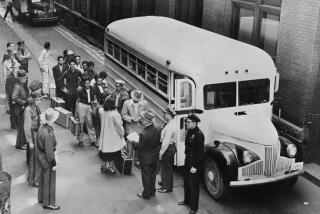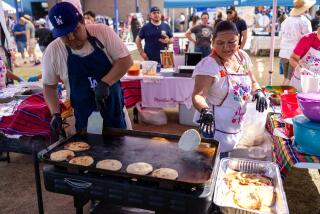Reaching Out Past a Taboo
- Share via
When Salvadoran immigrants asked Immanuel Presbyterian Church to give temporary shelter to their most important religious icon, the ramifications went well beyond the walls of the Wilshire Boulevard sanctuary.
The life-sized statue of the Divine Savior of the World represents the Salvadoran community’s national namesake and is a symbol of unity. Like many of the immigrants it protects and nourishes, the statue of Jesus came from Central America last year after an arduous journey through three countries. It would make perfect sense for Immanuel to embrace it, in keeping with its active ministry to immigrants.
There was one enormous obstacle: centuries of Protestant tradition against religious icons.
In a radical break with the past, the church has chosen broad unity over divisive taboos, agreeing to welcome and house the statue for the next week before it moves on to other churches. The decision to embrace the icon is aimed at symbolizing the church’s open-arms ministry to all immigrants, regardless of creed or color, according to Immanuel’s minister, the Rev. Frank Alton.
Alton acknowledged that the decision would disturb and even scandalize some Protestants, especially Latino immigrants who escaped Catholic persecution in their home countries and view the crucifix and other Catholic symbols as blasphemous idolatry.
But Alton--who has turned the venerable old church into a multicultural mix of street activism and rich liturgies in his six years there--said his congregation will welcome the icon.
“We are receiving the symbol not as an image of the Roman Catholic faith but in solidarity with the Salvadoran people and all immigrants of the world,” said Alton, who was asked to house the image by Salvadoran members of his congregation.
In a richly symbolic ceremony Friday night, a crowd of about 100 mostly Salvadoran immigrants welcomed the statue into the church. Outside the building’s wrought-iron gates, the participants enacted a posada-like drama of asking for shelter for their savior. They recounted how they brought it here to remind them of their homeland, of the struggles of all immigrants and of God’s grace in guiding them toward a new life of freedom.
The statue was brought to the front of the church cloister. Next, symbols of the immigrant experience were presented. There was dirt from places marking the horrors of El Salvador’s 12-year civil war, including the spots where four American nuns, six Jesuit priests and Salvadoran Archbishop Oscar A. Romero were murdered in separate incidents during the 1980s. Shoes, water and sand were presented. And so was a crucifix.
In his message, Alton drew parallels between journeys by immigrants today and God’s protection of the ancient Israelites during their wanderings in the wilderness before reaching the Promised Land. He urged people not to forget the lessons of the past.
“This symbol is inviting us to remember . . . that people are leaving their countries because of oppression and war,” Alton told the gathering. “They have to cross deserts, leave disasters, and in the middle of that experience is God’s grace.”
Immanuel’s decision to accept the icon will face its first popular test today, when most congregants see it in the cloister at services. Alton said the church board of elders raised no objection, but it flies in the face of centuries of tradition against icons that is particularly strong among Reformed churches such as Presbyterians and Baptists.
That taboo stems from 16th century Protestant reformers such as John Calvin, forefather of the Presbyterian tradition. The reformers viewed icons as corrupt idolatry that led people to focus on statues instead of a direct relationship with God, and to believe in an image’s magical powers of healing or salvation, according to Robert Johnston, a professor of theology and culture at Fuller Theological Seminary in Pasadena.
Worship of Idols Is Banned
Reformers also believed that the biblical commandment against worshiping idols and other gods applied to religious icons, and stressed the importance of the unseen spirit over the physical image, Johnston said. As a result, Protestant churches even today house crosses but not crucifixes bearing the figure of Jesus, as Catholics do. Nor do Protestants display the statues of Jesus, Mary or the saints that are ubiquitous in Catholic churches.
The differences underscore the Catholic focus on God’s immanence, or presence within creation, compared with the traditional emphasis on God’s transcendence, or distance beyond, among Presbyterians and other Reformed churches, Johnston said.
Catholics say their images are not idols but merely aids to help them focus on God. And that is what the Divine Savior of the World seems to do for those who flocked to Immanuel on Friday night.
“This figure makes God real,” said Byron Alerrera, 10, whose parents immigrated from Guatemala more than a decade ago. “We can’t see him, but we want to see him: what he looks like, what he does.”
In the next month, the statue will move to three more churches, culminating in an Aug. 5 celebration in Exposition Park to mark the feast of the transfiguration of Jesus and the day El Salvador was founded as a nation. The annual event, along with the journey of the Savior image among Los Angeles churches this year, is sponsored by the Salvadoran American National Assn. After that, organizers hope to take the icon to other churches around the country.
The image has touched people like Werner Marroquin, an Immanuel member who was raised to reject icons as the rare Protestant in his native El Salvador.
Accompanying the statue on its trek from El Salvador last year, Marroquin said he was moved by the enormous devotion evoked in all three countries it traversed. People dropped to their knees, prayed, cried and begged to touch the statue. He saw the icon’s power to unite people and hopes for a similar impact in Los Angeles.
“This is a humongous step for unity,” Marroquin said.
More to Read
Sign up for Essential California
The most important California stories and recommendations in your inbox every morning.
You may occasionally receive promotional content from the Los Angeles Times.













